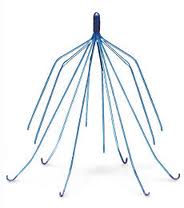The C.R. Bard Recovery® IVC filter was withdrawn from the market in 2005. Unfortunately, it has been linked to many severe side effects — including up to a 40% risk of filter fracture within five years. Broken pieces can travel to the heart and cause life-threatening complications.
What You Can Do & How We Can Help
The Schmidt Firm, PLLC is currently evaluating IVC filter cases in all 50 states, regardless of whether you have been injured or not. If you or somebody you know was implanted with an IVC filter, you should contact our lawyers immediately for a free case consultation. Please use the form below to contact our Defective Medical Device Litigation Group or call toll free 24 hours a day at (866) 920-0753.
Overview
The Recovery IVC filter is a medical device created by the company C.R. Bard, and it was approved by the FDA in 2003. It i implanted in the inferior vena cava (IVC), the largest vein in the body, where it catches blood clots before they get stuck in the lungs and cause a pulmonary embolism. IVC filters are mostly used in patients who cannot take a blood-thinning medication due to an injury or surgery.
What is the problem?
Recovery is a retrievable IVC filter, which means it is a short-term implant that must be removed as soon as the patient can take a blood-thinner or their risk of blood clots subsides. Unfortunately, studies have found that only about 20% of temporary filters are ever retrieved on average. Less than 10% are removed from trauma patients.
Complications Increase Over Time
Retrievable IVC filters are not designed to be permanent. In fact, many are designed to be weaker and more flexible than permanent filters, which makes the filter easier to remove. The longer an IVC filter remains in the patient’s body, the higher the risk of fracture, migration, and other serious complications. In 2010, the FDA published a Safety Communication about the risk of leaving a retrievable IVC filter in a patient too long.
Recovery IVC Filter Withdrawn
In 2005, Bard voluntarily stopped selling the Recovery IVC filter and replaced it with the G2 IVC filter. Bard sold the G2 with claims that it was more resistant to fracturing, migrating, and could be positioned more easily than the Recovery.
Approval Loophole Avoids Safety Studies
The Recovery was approved by the FDA under the 510(k) approval process. This process allows manufacturers to avoid conducting safety studies so long as the device is similar to an existing device. C.R. Bard did not conduct clinical trials of the Recovery IVC filter because it was “equivalent” to permanent filters. The FDA also considers IVC considers IVC filters to be Class II devices with a “low risk.”
Recovery Linked to 40% 5-Year Fracture Risk
In February 2012, a study found that 40% of Recovery IVC filters fractured after 5.5 years. Of the 363 people who were implanted with the Recovery, only 97 had the device removed. In some cases, fractured pieces of the Recovery migrated into the pulmonary arteries, femoral veins, heart (right ventricle), and renal vein.
Study Finds High Risk of Fracture and Embolization
In 2010, a study of 28 patients with the Recovery found that 7 filters (25%) fractured and traveled in the bloodstream (called “embolization”) within five years of implantation. In 5 of those 7 cases, the fractured piece traveled to the heart. The authors of the study warned:
“The Bard Recovery and Bard G2 filters had high prevalences of fracture and embolization, with potentially life-threatening sequelae.”
Bard Recovery Side Effects
Two of the most serious side effects of the Bard Recovery IVC filter are filter fracture or migration. The filter is designed with thin wire legs (called “struts”) in a cone shape. In these struts break, they can travel in the patient’s bloodstream and become trapped in an internal organ (usually the heart or lungs).
IVC Filter Fracture
Fractured filters do not always cause problems. In some cases, the pieces of the filter may erode and/or perforate the heart tissue, causing life-threatening conditions like cardiac tamponade (when fluid builds up around the heart and inhibits heart rhythm).
IVC Filter Migration
Migration of the filter is also a serious issue. If the filter shifts in position, it may become ineffective at preventing a pulmonary embolism. It may also be more likely to become clogged with clots, which could inhibit normal blood-flow through the inferior vena cava. The device could erode and/or perforate the inferior vena cava. It may also shift into a position where it is impossible to remove.
Do I have an IVC Filter Lawsuit?
The Schmidt Firm, PLLC is evaluating IVC filter cases in all 50 states, regardless of whether you were injured or not. If you or someone you know received an IVC filter implant, please contact our lawyers immediately for a free case consultation. You may be entitled to compensation by filing a lawsuit.
Please use the form below to contact our Defective Medical Device Litigation Group or call toll free 24 hours a day at (866) 920-0753.
Attention Lawyers: We consider a referral from another law firm to be one of the greatest compliments. If your firm is interested in referring us a case or for us to send you a list of previous award judgments and/or average referral fees, please visit the Lawyer Referral section of our website.


 The Schmidt Firm, PLLC has been recognized as one of the nation’s leading plaintiffs' law firms and handles cases in all 50 states. We are very proud of our legal achievements, but equally self-respecting of our firm's reputation for providing personal attention to each and every client we represent.
The Schmidt Firm, PLLC has been recognized as one of the nation’s leading plaintiffs' law firms and handles cases in all 50 states. We are very proud of our legal achievements, but equally self-respecting of our firm's reputation for providing personal attention to each and every client we represent.

